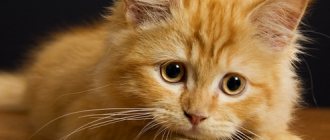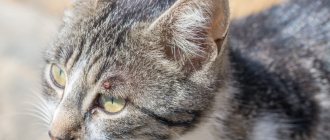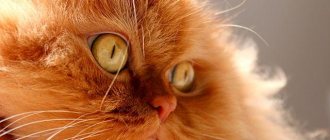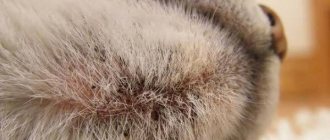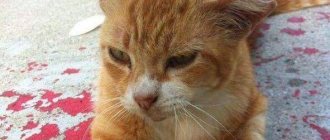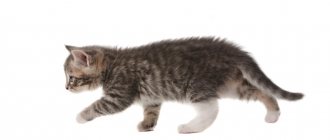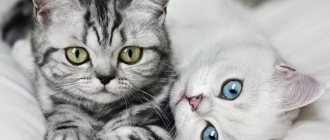When a cat loses hair on its chin, owners may at first not attach much importance to this symptom, chalking it up to seasonal shedding. However, complete baldness draws attention to itself, since the cause may lie in diseases that are in no way related to molting. It is also worth remembering that a disease such as lichen not only fits the symptom we are interested in, but is also considered contagious and dangerous for other animals and the owner himself. Things are simpler if the reason lies in poor hygiene or an allergic reaction.
Why does baldness occur?
There are many factors that provoke the manifestation of alopecia. Most often, this phenomenon occurs in short-haired cats. Before moving directly to the treatment of pathology, it is necessary to understand what caused the disease. The most common cause of a receding hairline is food allergies. Most often, cats are allergic to foods such as lamb, cereals, and proteins of plant or food origin. By adjusting your pet's diet, you can improve its health.
Hormonal imbalance can also cause the formation of bald spots in a cat. In this case, hair falls out not only in the ears or around the eyes, but also in other areas. With hormonal imbalance, baldness occurs in the abdomen, chest, hind legs, armpits, and also in the area near the anus.
Stress can trigger baldness in cats. When the cause of a skin disease is a psychogenic factor, the cat may also begin to lose hair in the abdomen, thighs and inner surface of the paws. In this case, the owner needs to provide his pet with the most peaceful living environment possible. Calming medications intended for cats will also have a beneficial effect on the health of your four-legged friend.
Alopecia sometimes results from dermatomycosis. In this case, increased hair loss is noticed in the area of the eyes and ears. The shape of bald patches with dermatomycosis has a ring-shaped or rounded shape. In problem areas, the skin is quite dry, however, the cat is not bothered by itching. The cause of the development of dermatomycosis is fungal diseases that negatively affect the epidermis and fur of the pet. Treatment of bald patches in cats is carried out using special antifungal agents.
We recommend the article: What causes black spots on the tongue of cats?
Causes of cheilitis
The inflammatory process can begin for multiple reasons. One of the most common of them is mechanical injuries: for example, accidental biting can cause inflammation.
The development of the disease can also be provoked by:
- unfavorable environment (people who spend a lot of time outdoors and are exposed to wind, frost and other weather conditions are more likely to suffer from cheilitis);
- aggressive action of cosmetics or an allergic reaction to some of their components;
- lack of vitamin B2, which is responsible for the division and growth of epithelial cells;
- diseases of the gastrointestinal tract, liver, lack of immunity.
Other causes of the disease
In rare cases, the factor that causes the appearance of bald patches is the following serious illnesses:
- Acromegaly;
- Problems with the thyroid gland (hypothyroidism);
- Diabetes;
- The period after castration;
- Hyperfunction of the adrenal cortex (Cushing's syndrome);
Other pathologies can also provoke the formation of bald spots. Some cats develop skin diseases due to allergies to medications. The presence of parasitic diseases also sometimes leads to alopecia.
In this case, it will be easy to notice the presence of parasites, since the influence of mites, lichen and cat scabies will immediately be reflected in the condition of the coat. In rare cases, bald patches appear in the presence of benign or malignant tumors. Hereditary factor is another reason for cat baldness.
Types of the disease, their symptoms
There are a large number of types of disease, each of which has its own symptoms. Cheilitis happens:
- catarrhal, resulting from injury. Its characteristic symptoms are redness, peeling, swelling and soreness of the lips.
- eczematous, developing due to the occurrence of eczematous processes. The reason is an allergy to a certain type of food, cosmetics (lipstick, cream).
- glandular, associated with an abnormality of the salivary glands. It happens that cheilitis on the lips accompanies periodontal disease, lupus, etc. The lower lip often suffers and begins to peel.
- meteorological. It is caused, as the name suggests, by weather conditions (high air humidity, strong wind, decreased or increased temperature, exposure to ultraviolet radiation, etc.).
- exfoliative, characterized by a chronic course. It is divided into two forms - dry (the blood supply to the lips is disrupted and, as a result, dry scales are formed, which can be easily removed, but after a few days they appear again) and exudative (the border swells and becomes inflamed, crusts appear).
- angular, called jam. Due to streptococci, inflammation begins in the corners of the lips. Vitamin deficiency and frequent licking of lips can also provoke it.
- atopic, accompanying atopic dermatitis. The red border of the lips flakes and itches, the lips crack.
- hypovitaminosis, which occurs due to a lack of B vitamins. Dryness and a pronounced burning sensation affect not only the lip area, but also the entire mucous membrane of the mouth, including the tongue. In this case, the mucous membrane turns red, and vertical cracks form in the area of the red border.
Regardless of the type of cheilitis, common symptoms will be:
- peeling of the lips, observed both only near the border and over the entire surface;
- swelling and swelling, burning and itching in the lips, the appearance of cracks and crusts on them.
Bald patches on a cat photo
Detailed description of possible causes
If a cat loses hair on its chin after black spots, red pimples, lumps or pink sores appear on it, then the reason may lie in scratching, since all of the above is accompanied by severe itching. Baldness of this area of the face in cats is almost always accompanied by accompanying symptoms that are difficult not to notice, as they cause a lot of discomfort to the animal. Especially in cases associated with an acute allergic reaction. Most often, this symptom is considered together with the following pathologies:
- Eosinophilic granulomas. Many veterinarians believe that eosinophilic granuloma can be caused by all types of allergies (food, atopic dermatitis, reaction to parasite saliva). Symptoms occur differently in each individual case. In some cases, single formations appear, sometimes the lesions spread to large areas of the skin. In many cases, chin hair loss in cats is caused by eosinophilic granuloma, which can be complicated by a secondary infection. First, the process develops against the background of redness of a separate area of the skin (usually the chin, lip, nose, less often the cheeks or ears). Then one or more pink plaques appear, slightly rising above the surface of the skin. For some, they are accompanied by severe itching; there are also cases when the formations do not bother the pet at all. Frequent licking of the lips and nose is also considered characteristic symptoms. Treatment in each case is individual, which should be based on local remedies and anti-inflammatory drugs. But, success will greatly depend on eliminating the provoking factor. Given that most allergies are not cured once and for all, exacerbations of eosinophilic granuloma in a pet can occur many times throughout its life. Good effectiveness was shown by daily treatment of the affected areas with a chlorhexidine solution (2-3 times a day), changing the brand of food, and eliminating plastic dishes from the animal’s diet.
- Lichen. It is more common in kittens and animals living outdoors. It is considered a contagious disease that can be transmitted to dogs and even humans. In rare cases, it occurs with minimal manifestations in the form of small spots on the skin. But, the most common form occurs when there is severe itching and hair loss. Most often the chin, ears, head are affected, and less commonly the limbs and tail. The spots can reach the size of a large coin. There is no fur inside the spot and there is weeping. There is almost always a flaky rim along the edges. If the animal reaches the lesions, it can lick or scratch them until they bleed. To make a diagnosis, an external examination of the animal by a veterinarian is required. Next, he will take scrapings from the lesions for microscopic and cytological examination. Good effectiveness is shown by glowing a cat under a Wood's lamp, where fungal spores will glow emerald. If the presence of fungal spores is confirmed, then depending on the severity of the symptoms and the age of the pet, treatment with antifungal drugs will be prescribed. Kittens under 8 weeks of age are prescribed only bathing with antifungal shampoos (Mikozoral, Perhotal, Nizoral, Imaverol). Adults are recommended to be treated with oral antifungal drugs (Terbinafine, Fungin). The duration of the course and dosage are prescribed by the veterinarian for each animal individually. Separately, it is necessary to write about the opinion of the majority of leading veterinarians in the country - vaccinations against lichen Vakderm and Polivac are not effective. It is recommended to pay special attention to disinfection of the premises and objects with which the infected animal comes into contact. For this purpose, products can be used that are marked as effective in killing dermatophytes. To speed up treatment and reduce the risk of spores spreading throughout the apartment, it is recommended to trim the sick animal.
Features of treatment
You can eliminate bald patches in a cat above the eyes or in another problem area by addressing the root cause of the disease. If parasites are the cause of the skin disease, it is necessary to provide the pet with proper treatment. The use of special ointments, gels and sprays that effectively affect parasites will help improve the condition of your pet. The cat owner should give the animal vitamins that will increase its immunity.
If local baldness occurs as a result of allergies, then it is necessary to limit contact with allergens. A hypoallergenic diet will improve your cat's health. In this case, the veterinarian prescribes the animal to take antiallergic drugs and immunostimulants.
When an animal has problems with the endocrine system, then it is recommended to select special treatment. Taking hormones will improve the cat's health and return its coat to its previous appearance.
Cheilitis in children
Depending on the age of the child, he may experience a certain type of cheilitis.
Newborns suffer from a catarrhal disease caused by the prolonged presence of a pacifier or bottle in the mouth. Plus, saliva accumulates on the nipples of the lips, irritating sensitive baby skin.
If the disease is ignored, hoping that it will go away on its own, cheilitis will develop into an exfoliative form, accompanied by the formation of scales, which the child will not be able to remove himself (parents are highly discouraged from interfering in this process, since attempts to tear off the crusts can cause cracks, which will only aggravate the situation ).
Constant sucking of the mother's breast is an equally common cause of the development of the disease: during feeding, cracks form on the nipples, into which bacteria penetrate, which causes cheilitis.
Treatment of hair loss in cats
Treatment for alopecia in cats depends on the cause and can only be prescribed by a veterinarian. Treatment boils down to the following activities:
- symptomatic treatment: aimed at eliminating the underlying disease, the symptom of which was alopecia.
- for skin lesions by parasites: preparations for blood-sucking insects (specialized shampoos, sprays, drops);
- for infectious skin lesions: a course of antibiotic therapy;
- in case of allergies, contact with its source is excluded, and if necessary, a diet is prescribed;
- under stress: exclude factors, including those that cause licking and plucking of hairs.
The doctor will advise strengthening the immune system and increasing the resistance (stability) of the body with auxiliary means. In addition, balance the diet in terms of basic nutrients, taking into account the norms for cats of different ages, breeds, physiological conditions (pregnancy, feeding, castration, etc.).
Local medications and physiotherapy are used as an addition to the main treatment.
Treatment of alopecia is a long process that must be monitored by a veterinarian; its prescriptions must be followed exactly, since the first signs of hair restoration do not indicate a complete cure, and in advanced cases, hair may not be restored.
Diagnosis of the disease
As soon as the owner of the animal notices that the cat’s tail is balding, you should not waste time, but immediately contact a veterinary clinic. The doctor must conduct a complete visual clinical examination of the animal, as well as prescribe a number of necessary tests.
Diagnostic measures, in addition to history taking and clinical examination, include:
- blood sampling (for general and biochemical blood tests);
- scraping the skin from the affected area (to determine the presence of pathogenic bacterial or fungal microflora);
- performing an ultrasound examination of the abdominal organs.
Based on the results obtained, the veterinarian prescribes an individual treatment regimen based on the severity of the pathological process, its type, the age of the animal and its body weight. Taking an anamnesis plays an important role in diagnosing tail baldness in cats.
The veterinarian must know in detail what the animal is fed, what medications were taken, and the presence of chronic diseases.
Causes of baldness in cats
The causes of baldness in cats can be congenital or acquired.
• Congenital include those that affected the body of a pregnant cat:
- lack of vitamins and minerals in the animal’s diet;
- stress;
- diseases of various nature;
- unbalanced diet;
- starvation and, as a result, exhaustion.
Exposure to these same causes even before pregnancy can serve as a prerequisite for the occurrence of alopecia in the future generation, as a result of which the fetus experiences disruption of the endocrine glands and disruption of the formation of hair follicles.
This should also include hereditary anomalies that arise, among other things, from inbreeding. However, it is important to clarify: if hereditary anomalies are accompanied only by the absence of hair (partially or completely), and not changes in the anatomical location of organs or disruption of their functioning, then we can talk about individual, and in some cases breed, affiliation. It is these anomalies that underlie the creation of cat breeds: Sphynx, Bambino, Elf, Ukrainian Levkoy, Cojona.
• Acquired baldness in cats can be a symptom of a disease of the skin itself:
- dermatitis (inflammatory skin diseases);
- seborrhea (increased secretion of the sebaceous glands);
- parasitic diseases (scabies) or fungal infections (ringworm, favus, trichophytosis).
This also includes alopecia, as a result of aging hair follicles, or from constant injury to certain areas of the hairline.
Another large group of factors that cause alopecia in cats are disturbances in the functioning of the body itself:
- stress: the cat itself intensively licks and plucks areas of the skin;
- allergies to food, medications, flea bites, odors, low-quality pet cosmetics, etc.;
- hormonal status disorders: diabetes mellitus, insufficient or excessive levels of thyroid hormones, adrenal glands, etc.;
- intoxication (acute or long-term infectious disease);
- inflammatory processes;
- blood diseases;
- condition after difficult childbirth;
- lack of vitamins, especially groups A, C, B;
- malignant tumors of internal organs.
In some cases, the cause of hair loss in a cat remains unknown, then we are talking about the unknown nature of baldness.

